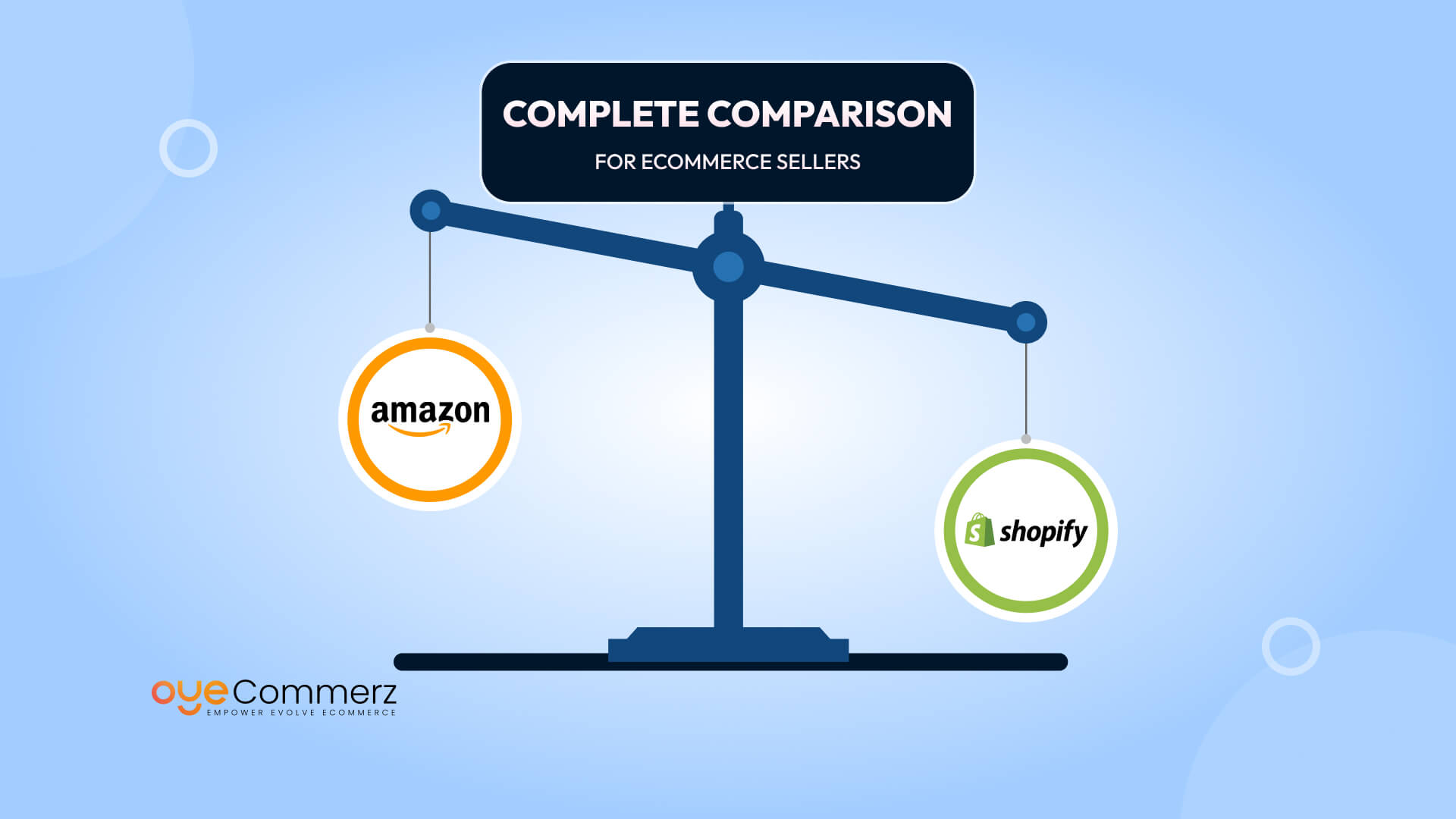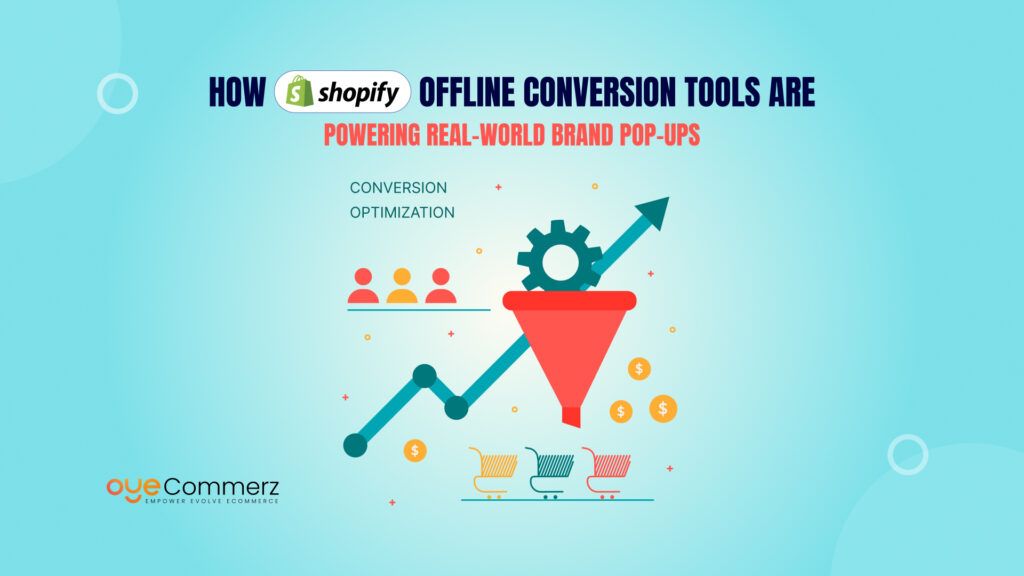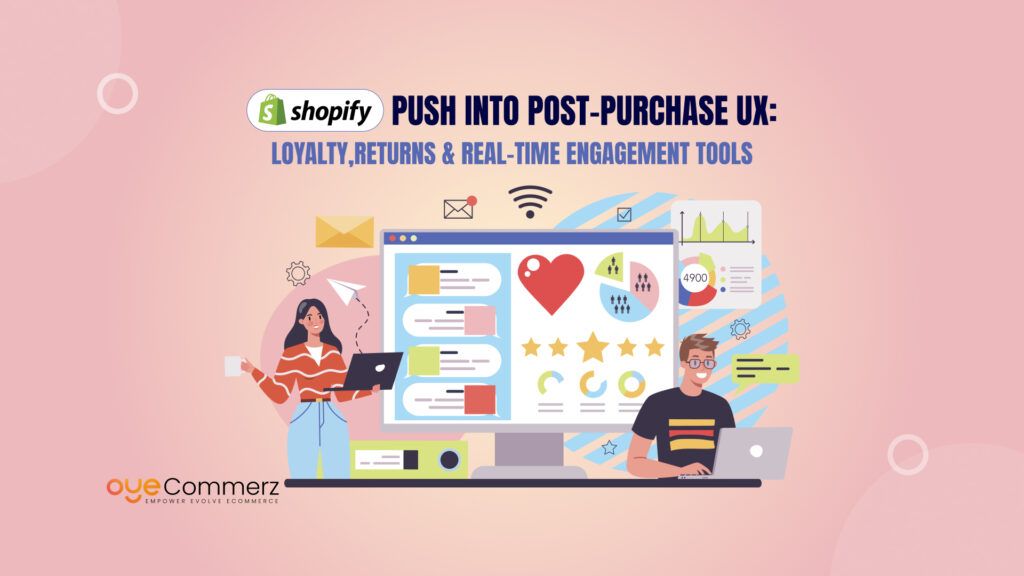Did you know global eCommerce sales are projected to hit over $7 trillion by 2025? As more businesses go digital and consumers shift toward online shopping, entering the eCommerce space has never been more attractive or more competitive.
With countless tools available for launching an online store, choosing the right platform can be the difference between just surviving and truly thriving. Whether you’re starting a new venture or scaling an existing business, the foundation you build on matters.
Two names dominate the conversation: Amazon and Shopify. Amazon gives sellers instant access to millions of buyers, while Shopify offers full control over branding and customer experience. But which one is better suited to your business goals?
In this guide, we’ll break down the core differences between Amazon or Shopify to help you make an informed decision. From setup and fees to scalability and customer ownership, we’ll explore every angle so you can confidently choose the best platform for your eCommerce journey.
Table of Contents
TogglePlatform Overview
What is Amazon?
Amazon is one of the world’s largest online marketplaces, connecting millions of buyers and sellers across virtually every product category imaginable. Rather than creating their own websites, sellers list products directly on Amazon’s platform, allowing them to tap into its massive built-in customer base.
Key Stats and Reach
- Over 310 million active customers globally
- More than 200 million Prime members worldwide
- Hosts over 9.5 million sellers, with more than 2 million active sellers as of 2024
- Operates in 20+ global marketplaces, giving sellers international exposure
Types of Sellers on Amazon
Amazon accommodates a wide range of sellers, including:
- Individual sellers offering a few products as a side hustle
- Professional sellers running full-time eCommerce businesses
- Private label brands who manufacture and sell their own products
- Retail and wholesale resellers listing third-party products for profit
Amazon also provides fulfillment services through Fulfillment by Amazon (FBA), allowing sellers to store inventory in Amazon’s warehouses and let the company handle shipping, customer service, and returns.
What is Shopify?
Shopify is a leading eCommerce platform that enables entrepreneurs and businesses to create their own branded online stores. Unlike Amazon, which is a marketplace, Shopify is a website builder specifically designed for selling products, offering full control over design, functionality, and customer experience.
Flexibility and Control for Merchants
With Shopify, sellers can:
- Customize their storefront with themes and apps
- Sell across multiple channels (including social media and marketplaces)
- Manage inventory, payments, shipping, and marketing all in one place
- Access detailed analytics and customer data for personalized marketing
Shopify supports a subscription-based model, where you pay a monthly fee to access the platform’s features, plus any additional charges for apps or third-party tools.
Shopify’s Growth and Usage
- Powers over 4.5 million live websites worldwide
- Used in 175+ countries
- Facilitates sales of over $700 billion since its inception
- Trusted by global brands like Gymshark, Allbirds, and Heinz, as well as millions of small businesses
Shopify’s appeal lies in its balance of simplicity and power whether you’re a solo entrepreneur or a large brand, it scales with your growth while keeping your business entirely under your control.
Key Differences at a Glance
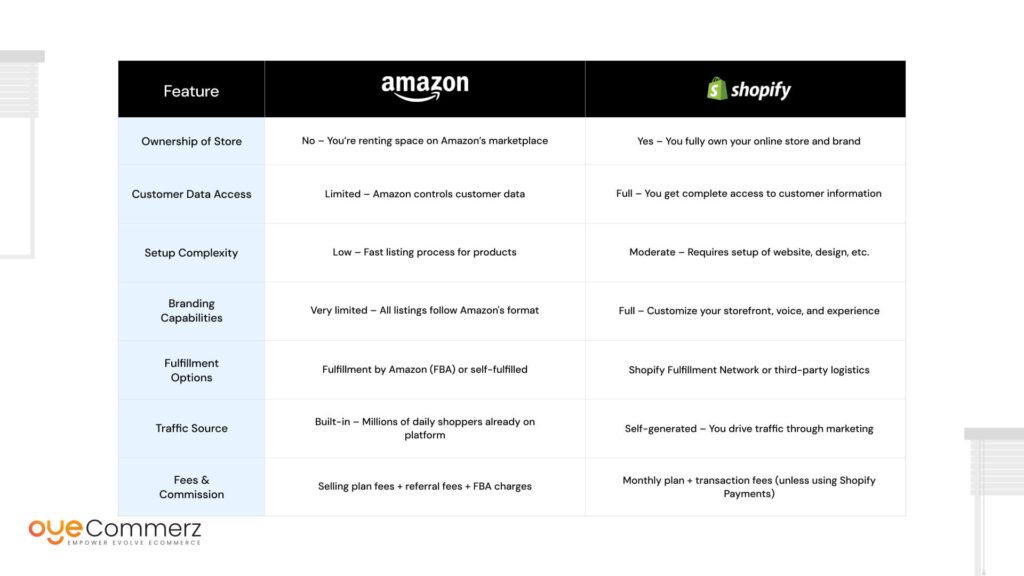
In-Depth Comparison by Feature
1. Ease of Use & Setup
Amazon:
Getting started on Amazon is straightforward. Sellers can choose between an Individual or Professional account, list products by filling out predefined fields, and start selling almost immediately. There’s no need to worry about web design or hosting. However, navigating Amazon’s backend tools (like Seller Central) can become complex as your catalog grows.
Shopify:
Shopify offers a user-friendly interface that lets you build a custom storefront without needing technical skills. The setup involves selecting a theme, adding products, configuring payment and shipping settings, and launching your site. Shopify’s dashboard is intuitive and ideal for both beginners and experienced users who want more control over their eCommerce experience.
2. Customization & Branding
Amazon:
All product listings follow a uniform structure, which limits branding opportunities. Your store shares the spotlight with competitors, and your brand identity can easily get lost. While Amazon Stores and A+ Content offer limited enhancements, it’s still nowhere near the creative control other platforms offer.
Shopify:
Shopify is built for branding. From your logo and colors to layout and messaging, every part of the customer journey can be customized. Themes, plugins, and custom code allow for a completely unique experience tailored to your brand identity.
3. Customer Reach & Traffic
Amazon:
Amazon’s biggest advantage is its massive, built-in customer base. Millions of users search the platform daily, and your products can show up right in front of ready-to-buy shoppers. This reduces your need to run traffic-driving campaigns, especially for popular products.
Shopify:
On Shopify, you’re building from the ground up. That means you’ll need to generate traffic through marketing such as SEO, paid ads, social media, email marketing, or influencer partnerships. While it’s more work upfront, you get the benefit of full control and long-term brand equity.
4. Fulfillment & Shipping
Amazon:
Fulfillment by Amazon (FBA) takes care of picking, packing, and shipping, plus customer service and returns. Products enrolled in FBA also become Prime-eligible, which boosts conversion rates. However, fees can add up, and you must follow strict inventory guidelines.
Shopify:
Shopify offers its own Shopify Fulfillment Network, along with integrations for third-party logistics (3PLs). You manage how and where your orders are fulfilled, giving you flexibility in cost and service levels. It’s ideal for sellers who want control or use custom packaging.
5. Fees and Pricing
Amazon:
- Individual Plan: $0.99 per sale
- Professional Plan: $39.99/month
- Referral Fees: 6% 45% depending on category (most around 15%)
- FBA Fees: Based on size/weight and storage duration
These fees can quickly stack up, especially for low-margin products.
Shopify:
- Basic Plan: $39/month
- Shopify Plan: $105/month
- Advanced Plan: $399/month
- Transaction Fees: 0–2% unless using Shopify Payments
- App Costs: Vary based on features you add
While more predictable costs can grow as you scale and add apps or features.
6. Control Over Customer Data
Amazon:
Amazon does not give you access to customer emails or other personal data. You can’t build a list or remarket directly to past buyers, which limits relationship-building and long-term growth.
Shopify:
With Shopify, you own all your customer data, including email addresses, order history, and behavior. This empowers you to build loyalty, run personalized marketing campaigns, and grow your business through retargeting and email lists.
7. Marketing & SEO
Amazon:
Amazon has its own advertising platform (Amazon Ads) that allows you to promote your listings with sponsored product ads. You can also benefit from user reviews, bestseller rankings, and deal placements but all within Amazon’s ecosystem.
Shopify:
Shopify gives you full flexibility to run marketing campaigns across channels. You can optimize for Google SEO, run Facebook and Instagram ads, use email marketing tools, collaborate with influencers, and install marketing apps. The downside? You’re responsible for getting eyeballs on your store.
8. Scalability
Amazon:
Amazon is built to handle massive scale. You can start small and expand into international marketplaces using Amazon Global Selling. Their infrastructure handles warehousing, fulfillment, and traffic making it easy to grow.
Shopify:
Shopify is equally scalable but in a different way. As your business grows, you can upgrade plans, add apps, customize features, and even use Shopify Plus (for enterprise brands). You control every aspect of the growth path from product range to user experience.
Pros and Cons Summary
Amazon: Pros & Cons
Pros:
- Large built-in customer base with millions of active shoppers
- Fulfillment by Amazon (FBA) simplifies logistics and enables fast shipping
- Prime eligibility can boost visibility and conversions
- Fast and easy product listing and launch process
- Trusted platform with strong consumer confidence
Cons:
- Limited control over branding and store presentation
- High and often complex fee structure (referral fees, FBA fees, etc.)
- No access to customer data, limiting long-term relationship building
- Intense competition, including from Amazon’s own private-label products
- Risk of account suspension or policy violations without much recourse
Shopify: Pros & Cons

Pros:
- Full control over branding, design, and user experience
- Complete ownership of customer data and ability to build loyalty
- Scalable with a wide range of apps and integrations
- Multichannel selling capabilities (social media, Google, marketplaces, etc.)
- Transparent pricing with no commission on sales (if using Shopify Payments)
Cons:
- No built-in audience; traffic must be generated through marketing efforts
- Requires initial setup time and effort to launch a store
- Additional costs may arise from third-party apps and services
- Fulfillment and logistics need to be managed independently unless integrated with a provider
Which Platform Is Right for You Amazon or Shopify?
Choosing between Amazon and Shopify depends on your business model, goals, and long-term vision. Here’s how to determine which platform best fits your needs:
Best for Beginners: Amazon
If you’re new to eCommerce and want to start selling quickly without investing heavily in marketing, Amazon is a solid starting point. With an existing customer base and streamlined fulfillment through FBA, it allows you to focus on product sourcing and inventory rather than traffic generation or web design.
Use Amazon if:
- You want fast access to a large marketplace
- You prefer a plug-and-play selling experience
- You’re testing new products or doing retail arbitrage
- You want logistics handled through FBA
- You’re not ready to build a standalone brand
Best for Brand Builders: Shopify
Shopify is ideal for sellers who want full control over their business and customer experience. If your goal is to build a recognizable, long-term brand with repeat customers and personalized marketing, Shopify offers the flexibility to grow your online presence on your terms.
Use Shopify if:
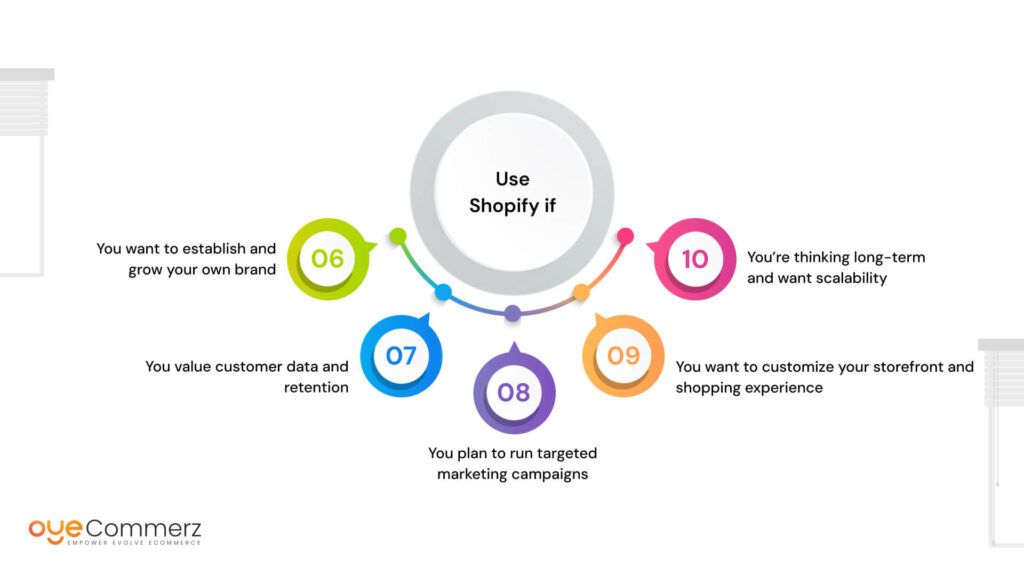
- You want to establish and grow your own brand
- You value customer data and retention
- You plan to run targeted marketing campaigns
- You want to customize your storefront and shopping experience
- You’re thinking long-term and want scalability
Ideal Use Cases: Amazon vs. Shopify
Use Case | Best Platform |
Selling trending or commodity products | Amazon |
Launching a niche brand | Shopify |
Dropshipping or custom products | Shopify |
Quick sales without heavy marketing | Amazon |
Building customer loyalty | Shopify |
Testing demand before scaling | Amazon |
Consider a Hybrid Approach
Many successful sellers use both platforms to maximize reach and growth. For example, you can start selling on Amazon to generate cash flow while simultaneously building your own Shopify store for long-term branding and customer loyalty. This approach lets you enjoy the best of both Amazon’s traffic and Shopify’s control.
Ready to Grow Your eCommerce Business?
Whether you’re migrating to Shopify or need custom solutions, Oyecommerz is your trusted partner for seamless eCommerce development. Our expert team will help you scale, optimize, and build a brand that stands out. Contact us today to start your Shopify journey, or request a free consultation to see how we can take your online store to the next level.
Let's build your custom Shopify app today!
Conclusion
Choosing between Amazon and Shopify ultimately depends on your business goals, budget, and long-term vision. Amazon is ideal if you’re looking for quick sales, easy setup, and immediate access to a massive customer base, making it perfect for sellers who need fast traction. On the other hand, Shopify is the best option if you aim to build a unique, long-term brand, own your customer data, and have full control over your store’s design and functionality. Many sellers benefit from using both platforms, Amazon to leverage its vast reach and Shopify to build a sustainable, branded business. Ultimately, the right platform is the one that aligns with your specific business needs and growth plans.
Frequently Asked Questions
Shopify allows you to create and fully customize your own online store, giving you complete control over branding, design, and customer experience. You own your customer data, can build email lists, run personalized marketing campaigns, and sell across multiple channels like Facebook, Instagram, and Google. In contrast, Amazon is a marketplace where your products are listed alongside competitors, with limited branding and no access to customer data.
Yes, many entrepreneurs and businesses make significant income using Shopify. Success depends on product quality, marketing strategy, customer experience, and consistency. Unlike marketplaces, Shopify gives you control over your brand and customer relationships, which helps in building long-term profitability. Many brands use Shopify to scale from small side hustles to multi-million dollar businesses.
There’s no one-size-fits-all answer.
Amazon is better for fast setup, access to a large customer base, and quick sales.
Shopify is better for long-term growth, brand building, and owning your customer relationships.
If you’re focused on creating a unique brand and scaling over time, Shopify is the better option. For quick exposure and simpler logistics, Amazon is more suitable.
Profitability depends on your business model.
Amazon may bring faster sales, but it also comes with higher fees and intense competition.
Shopify requires more effort in marketing and setup, but gives you higher profit margins, better customer retention, and more control over costs.
For sellers who want to build a brand and reduce reliance on paid platforms, Shopify tends to be more profitable in the long run.

